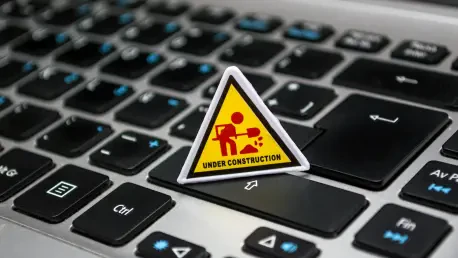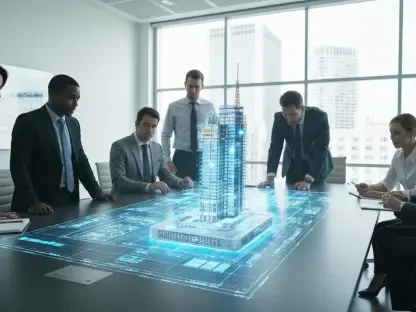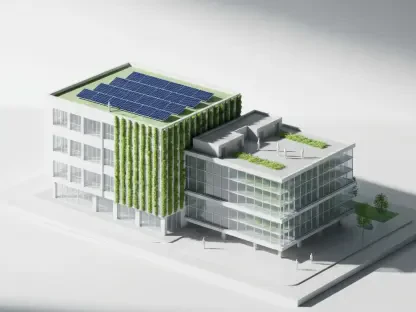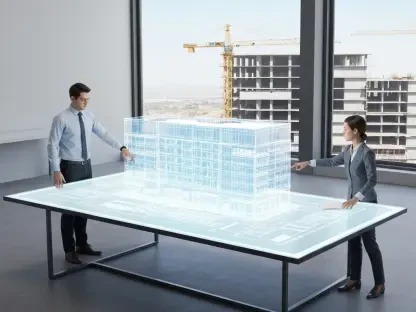The construction industry is undergoing a significant transformation, fueled by integrating innovative technologies like Augmented Reality (AR) and Building Information Modeling (BIM). These advancements reshape traditional construction methodologies, introducing a vast array of improvements in project management. By enabling real-time collaboration and visualization, AR and BIM help streamline processes, enhance productivity, and improve quality control, thus revolutionizing how construction projects are conceived and executed. As the industry navigates modern challenges, these technologies offer pragmatic solutions to age-old problems.
Enhancements in Productivity and Workflow Efficiency
Real-Time Data Sharing and Visualization
The utilization of AR and BIM in the construction industry epitomizes a progressive shift toward enhancing productivity and ensuring workflow efficiency. These tools provide construction professionals with the ability to visualize and manipulate 3D models superimposed on real-world environments, fostering an immersive experience that enhances comprehension and execution. By facilitating real-time data sharing, they bridge the gap between planning and execution, enabling teams to access up-to-date information at their fingertips, ultimately ensuring the alignment of efforts with the overall project goals.
Engaging in real-time visualization aids in identifying potential design discrepancies early and expedites decision-making processes by presenting stakeholders with a comprehensive view of ongoing progress. This capability often results in preventing costly errors and reworks, as potential inconsistencies can be detected and addressed promptly. Moreover, the democratization of data across teams encourages collaborative efforts, resulting in a seamless exchange of ideas and a unified approach to problem-solving. AR and BIM technologies collectively ensure that design and execution remain synchronized throughout the project’s lifecycle.
Streamlining Communication and Collaboration
The integration of AR and BIM within the construction framework has significantly enhanced communication streams, fostering transparent interactions among project stakeholders. By leveraging AR, teams can overlay digital information on physical sites, which serves as an effective medium for conveying complex concepts intuitively. This tangible representation aids in aligning diverse teams, providing a common point of reference that transcends language barriers, technical jargon, or geographical limitations.
Furthermore, these technologies enable collaborative workflows involving multiple parties, including architects, engineers, contractors, and clients. The resulting synergy allows for a more holistic approach to project execution, where feedback and input can be seamlessly incorporated at every stage. This collective endeavor enhances project efficiency and ensures adherence to timelines and budgets. The transparency offered by AR and BIM reduces the potential for miscommunication or oversight, resulting in projects that more accurately reflect the intricate designs and specifications set forth during the initial planning phases.
Assurance of Quality and Compliance
Advanced Modeling and Code Adherence
One of the pivotal roles that AR and BIM play in the construction industry lies in quality assurance and compliance. By providing a robust framework for 3D digital modeling, these technologies allow for meticulous planning and execution of building designs, ensuring adherence to predefined project specifications and building codes. This meticulous level of detail facilitates a systematic approach to identifying potential issues before they manifest in physical construction, reducing the likelihood of non-compliance and associated delays.
Additionally, AR complements BIM by overlaying real-time models onto existing sites, offering construction personnel a tangible reference point for evaluating progress and identifying alignment with intended designs. This capacity is invaluable for ensuring that every phase of construction aligns with rigorous safety protocols, quality standards, and regulatory requirements. As a result, construction companies that harness these tools can proactively address potential setbacks, maintain compliance, and deliver superior results.
Improving Quality Control Measures
Incorporating AR into BIM platforms revolutionizes traditional methodologies associated with quality control within the construction sector. AR’s ability to render digital models in situ, combined with BIM’s comprehensive data processing capabilities, equips teams with unparalleled insights into the project’s current state versus its planned trajectory. By providing a virtual reality overlay of completed and pending builds, construction personnel have the tools to perform immediate quality assessments.
Effective quality control demands precision, and AR-enhanced BIM workflows empower construction teams to supervise every element with meticulous attention, quickly pinpointing and rectifying any discrepancies. The visual clarity offered by this technology prevents errors from slipping noticed, thereby enhancing the reliability of the entire construction process. Additionally, with these technologies in place, construction managers can consistently track project insights, aiding in the transparent communication of progress and outcomes with clients and stakeholders.
Advancements in Safety and Training
Reducing Incidents Through Predictive Analysis
Safety remains a paramount concern within the construction industry, given its inherently risky nature. However, AR and BIM have proven instrumental in mitigating these dangers by offering predictive capabilities that identify and minimize safety risks. The integration of AI and data analytics into BIM systems enables the identification of patterns linked to accident occurrences. This foresight allows teams to proactively adjust workflows, implement precautionary measures, or halt operations to prevent potential accidents, thereby fostering a safer workplace environment.
These preventative strategies result in notable reductions in incident rates, benefiting employee well-being and enhancing project timelines and cost allocations. The intersection of AR and AI in BIM platforms ensures comprehensive safety measures, positioning digital technology at the forefront of minimizing occupational hazards. By visualizing potential pitfalls and adjusting site conditions accordingly, augmented safety protocols yield tangible improvements in construction safety metrics.
Facilitating Innovative Training Programs
AR’s integration with BIM also revolutionizes training programs for construction workers. By employing immersive simulations and augmented reality environments, these technologies enable a hands-on approach to training without the risks associated with real-world learning. Construction personnel can engage with virtual scenarios that mimic complex tasks and processes, equipping them with necessary skills and knowledge while providing instructors with the opportunity to provide real-time feedback.
Enhanced training methodologies featuring AR and BIM increase workforce comprehension of modern construction techniques. This approach not only accelerates the learning curve but also bridges the gap between theoretical knowledge and practical application. Skilled workers contribute to overall project efficiency by reducing the margin of error during construction tasks. Ultimately, advanced training regimens ensure that the construction workforce remains competent, confident, and adept at navigating evolving industry demands.
Real-Time Resolution and Oversight Improvements
Managing Issues Proactively
The integration of AR and BIM technologies within construction practices facilitates proactive issue management by providing real-time insights and allowing teams to visualize discrepancies as they arise. Armed with AR-compatible devices, construction professionals can superimpose BIM models onto their physical spaces, enabling them to conduct ongoing assessments and ensure precision throughout the build process. This ability to compare planned models with actual work completed on-site offers an invaluable perspective, highlighting deviations for immediate resolution.
Through this dynamic approach, construction managers can coordinate issue management efforts by identifying recurring challenges with suppliers or workflow processes. Instead of reacting to problems after they manifest, AR and BIM empower teams to engage in preventative interventions that optimize project output. This forward-thinking strategy safeguards against unnecessary disruptions that could culminate in extended project delays or increased costs. As such, this innovative application of technology within construction becomes a cornerstone for maintaining project integrity.
Enhancing Supplier and Workflow Oversight
The fusion of AR and BIM fosters improvements in supplier oversight and workflow management, providing stakeholders with enhanced transparency and increased accountability. By visualizing construction deliverables through AR, contractors can ensure that all materials align with project specifications and maintain supplier standards. This visualization process promotes informed decision-making and fosters collaboration between suppliers and project managers, ultimately ensuring that supply chains operate as efficiently and predictably as possible.
Furthermore, the use of AR-enabled BIM platforms engenders robust oversight of workflow processes, allowing stakeholders to track performance and pinpoint inefficiencies. Real-time monitoring supports continuous improvement by promoting agile responses to changing conditions or unexpected setbacks. Construction teams can capitalize on these insights to implement corrective actions that enhance productivity, optimize resource allocation, and maintain project momentum. Leveraging digital tools in this capacity facilitates transformative changes in how construction projects unfold from planning through completion.
Future-Ready Construction with AR and BIM
The construction industry is experiencing a noteworthy transformation due to incorporating cutting-edge technologies like Augmented Reality (AR) and Building Information Modeling (BIM). These advancements redefine traditional construction methods, bringing a multitude of enhancements in project management. AR and BIM facilitate real-time collaboration and visualization, allowing teams to streamline processes, boost productivity, and enhance quality control. This is leading to a revolution in how construction projects are planned and executed. In an era marked by complex challenges, these technologies provide practical solutions to longstanding issues. They enable stakeholders to identify potential design flaws early, minimizing costly changes later in the process. Furthermore, AR enables workers to visualize complex components in a real-world context, reducing the likelihood of errors during construction. As the industry continues to evolve, adopting AR and BIM is becoming increasingly crucial for companies aiming to stay competitive in a fast-paced, ever-changing environment.









